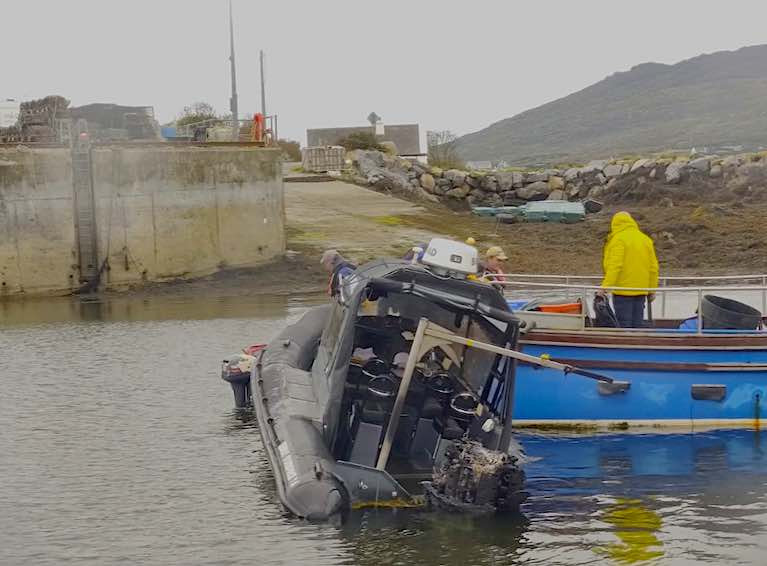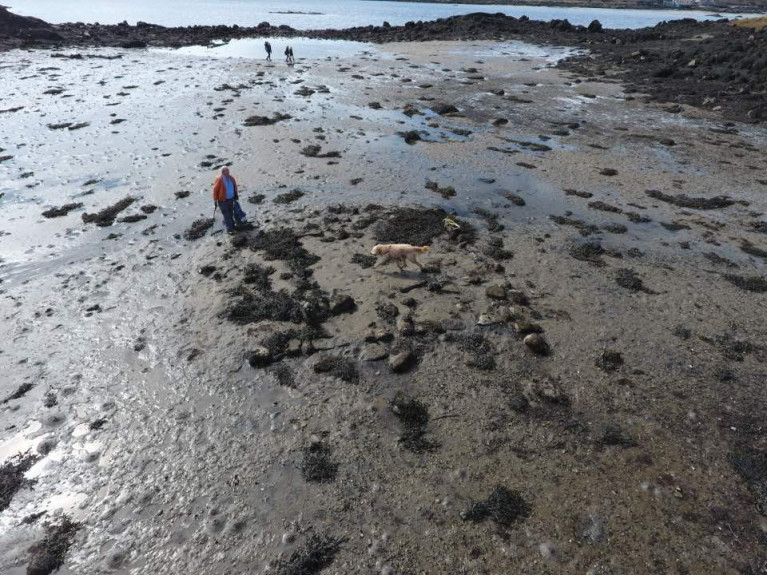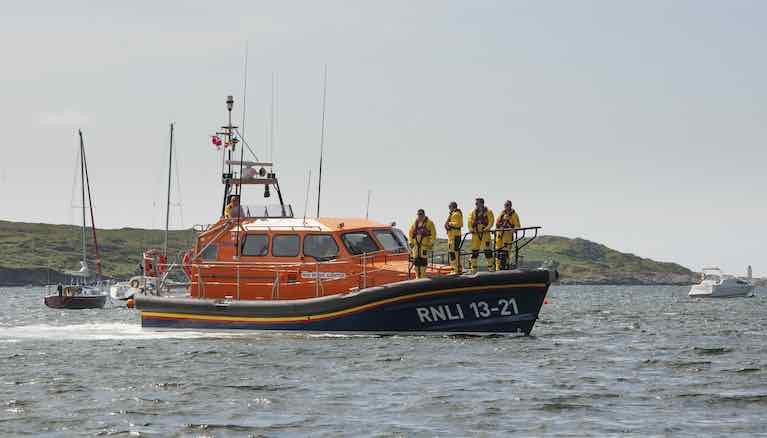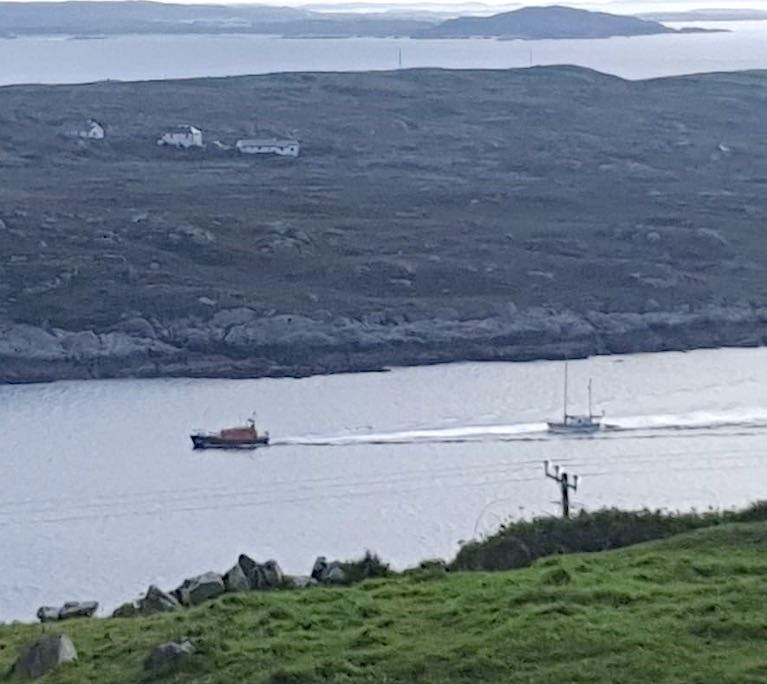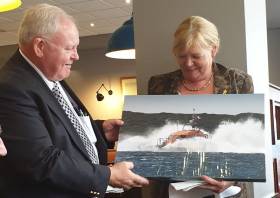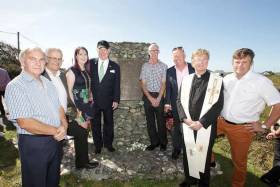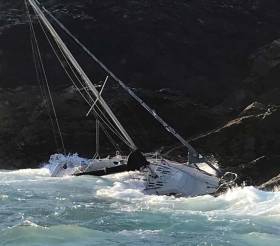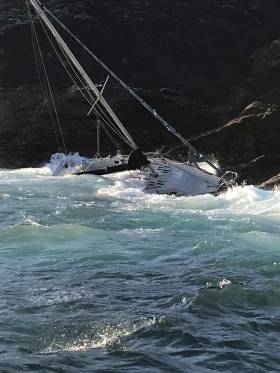Displaying items by tag: Clifden
Clifden RNLI Lifeboats Recover Sinking Trawler with Two Onboard
Both lifeboats at Clifden RNLI were launched this morning just before 11 am after a Coastguard request to go to the aid of a ten-metre fishing trawler that was taking on water and in danger of sinking.
With two crew on board, the trawler was on passage to Clare when they raised the alarm.
While wind conditions were a south westerly force 3/4, there was a very large swell on the scene and another large tanker vessel nearby.
All weather lifeboat coxswain James Mullen explained ‘When the lifeboats arrived on scene there was a large tanker vessel providing the casualty vessel with some shelter from the 7/8 meter seas.
 .With two crew on board, the trawler was on passage to Clare when they raised the alarm
.With two crew on board, the trawler was on passage to Clare when they raised the alarm
The Atlantic 85 helm Joe Acton immediately transferred two crew aboard with a salvage pump and began pumping out the vessel. Once the water level dropped low enough for the vessel to use their own engine power we headed back to shore.
However, on the way to Clifden the boat started to take on more water than the two pumps could handle and the engine overheated so we made the decision then to take her under tow. The larger salvage pump was transferred from the Shannon class lifeboat to the casualty via the inshore lifeboat by crew member Chris Nee.
With both lifeboats pumps working and the vessels own bilge pump, the flow of water was stemmed and the boat was escorted safely back to Clifden. Both helicopters Rescue 115 and 118 were also on scene and we are glad to have been able to bring the casualties and the vessel safely back to shore’.
Clifden RNLI Deputy Launching Authority John Roberts said ‘The crew did extremely well today in a very large swell to carry out this rescue and without their assistance this vessel was in serious danger of sinking. Well done to all involved.’
The Shannon class lifeboat was crewed by James Mullen, John Mullen, Ashling Sweeney, Chris Nee and Andrew Bell and the Atlantic 85 boat was crewed by Joe Acton, Brian Ward and Thomas Davis.
Launch of New Irish Children’s Book on Connemara is a Boost to Clifden Lifeboat Team
A new children’s book focusing on the local history and mythology of the North West Connemara region has been launched this week in Co Galway.
And a portion of the proceeds is being donated to the Clifden RNLI lifeboats for their dedication to saving lives at sea.
Local author and youth worker Marie Feeney has produced From Our Ancient Land to Bountiful Sea, an informative and often humorous collection of local history and folklore tales with illustrations by Gary Kendellen.
These tales include accounts of the famous engineer Alexander Nimmo, who designed many piers and bridges in the Connemara area, and a blend of local history and myths that will appeal to locals and visitors alike.
Marie’s first book The Cleggan Disaster comprehensively and poignantly detailed the tragic drowning of 45 men from the fishing communities of Cleggan, Claddaghduff and Inishbofin and the Inishkeas, and also benefitted the local RNLI lifeboats.
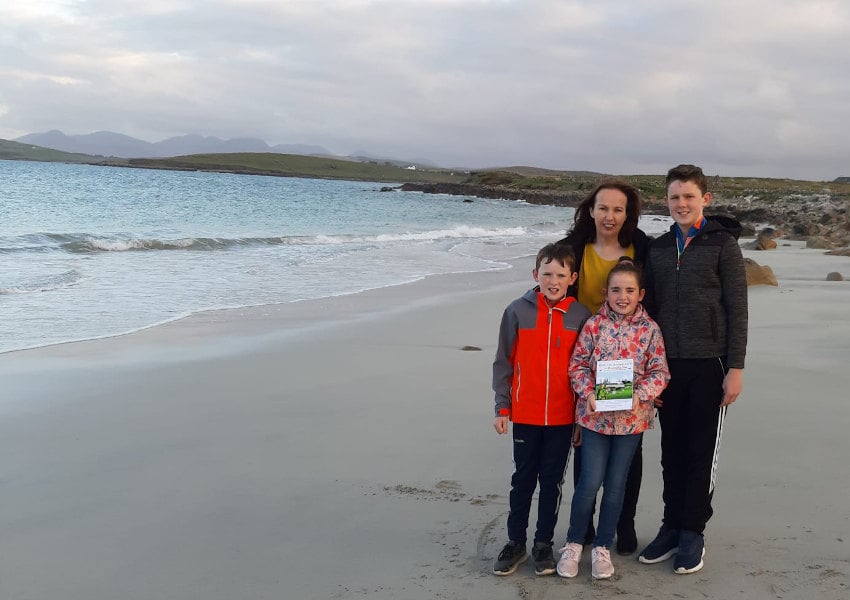 Author Marie Feeney with her children Ronan, Diarmuid and Michaela at Sallerna Beach in Cleggan, Co Galway | Photo: Marie Feeney
Author Marie Feeney with her children Ronan, Diarmuid and Michaela at Sallerna Beach in Cleggan, Co Galway | Photo: Marie Feeney
On the launch of her new book, Marie said: “The coastline of Connemara, while exceptionally beautiful is also treacherous and mostly utilised by people who use it either for pleasure or their livelihood.
“Thankfully in our community, we have a dedicated RNLI volunteer team who provide an invaluable service by saving lives each year, sometimes in the most challenging environments.
“The philosophy of the RNLI is astounding. The purpose to save lives, their vision to save everyone, their volunteer ethos, their charitable and community base. Every life matters, and of course their maritime expertise is crucial.”
From Our Ancient Land to Bountiful Sea is now on sale locally in Connemara at The Clifden Bookshop, Letterfrack Country Shop, Gala Cleggan and Sweeney’s Claddaghduff. The book is also available online at the inConnemara Bookshop.
Clifden RNLI Launch to Fire on Diver's RIB in Roundstone
Three divers were rescued by the RNLI Clifden lifeboat yesterday after their rigid inflatable boat (RIB) caught fire in Bertraghboy bay near Roundstone, Co Galway.
Shortly before 3 pm yesterday (Monday, Sept 21st) Clifden RNLI launched their Shannon class all-weather lifeboat in response to a Mayday call to the Coastguard from a Rigid Inflatable Boat (RIB) that had caught fire in Bertraghboy Bay near Roundstone.
The three people on board had inflated their life raft, evacuated the RIB and were taken under tow by a local fishing vessel. They had been diving approximately 3 miles offshore when the incident happened.
Clifden RNLI said that the three people on board had inflated their life raft, evacuated the RIB and were taken under tow by a local fishing vessel. They had been diving approximately three miles off shore when the incident happened.
The Shannon class lifeboat Brianne Aldington arrived at the scene approximately 55 minutes after launch, it said.
Aran Island RNLI, which had also been requested to launch, was stood down shortly afterwards - as was Clifden’s Atlantic 85 inshore lifeboat, once it was clear the situation was under control, it said.
The Irish Coastguard helicopter Rescue 115 from Shannon was on scene while the lifeboat escorted the casualties into Inishnee pier, where they were met by members of Cleggan Coastguard.
Coxswain James Mullen said ‘“While this was obviously a very upsetting thing to happen, the boat was very well equipped and the sailors had taken every safety precaution to deal with an emergency scenario like this. “
“We wish them well and commend their quick actions and also of course the local vessel that went to their aid as quickly as possible, in what have could otherwise have been a disastrous incident, “ Mr Mullen added.
Further Evidence of Sea Level Rise Along the Atlantic Coast Uncovered on North Connemara Inter-Tidal Zone
Discovery of the remains of a “drowned” prehistoric house in north Connemara may be further evidence of sea-level rise along the Atlantic coast in the last millennium.
As The Sunday Times reports today, parts of a small prehistoric dwelling covered by sea except at low spring tide have been identified by archaeologist Michael Gibbons and engineer Shane Joyce on the coast south-west of Clifden, Co Galway.
The site is in a sheltered “lagoon-like setting” on the tip of the Faul peninsula, at the junction of Clifden and Ardbear bays.
Gibbons said that the structure is similar in size to early Neolithic houses, and it is protected from tidal surges by Oileán Gearr or Islandagar, a small island on its western side.
Gibbons said it was further evidence of a “drowned prehistoric landscape”, which has been researched and dated by NUI Galway palaeoecologists Prof Michael O’Connell and Dr Karen Molloy.
O’Connell and Molloy have estimated that sea levels rose by as much as four metres on the Atlantic coast in later prehistory - as in 1,000 years ago – with Galway Bay being younger than originally estimated.
Prof O’Connell said that it was “quite reasonable” to suggest the structure identified by Gibbons and Joyce may be early Neolithic, given that sea level rise occurred in the late Neolithic period.
O’Connell and Molloy’s work focused on tree stumps, believed to be bog pine, which have been exposed at low tide by storms dating back to 2010, along with pollen analysis of coastal peat deposits.
Gibbons said that a shell midden dating from 4,000 BC on the Errislannan peninsula, just south-west of the Faul location, was also evidence of Neolithic settlement by early farmers.
Read The Sunday Times report here
Clifden RNLI Launch All-Weather Lifeboat to go to the Aid of Child with a Suspected Broken Leg on Inishbofin
Clifden RNLI’s all-weather lifeboat was tasked by the Coast Guard last weekend (Saturday 15 August) to assist with the medical evacuation of a 10-year old girl with a suspected broken leg, on Inishbofin. The calm conditions made for a gentle crossing by lifeboat and the girl was transferred into the care of HSE paramedics at Cleggan.
The lifeboat was tasked at 6.50pm and was underway to Inishbofin at 7.10pm with an expected journey time of 30 minutes. The district nurse on Inishbofin had requested assistance after the casualty was involved in a biking accident while exploring the island. Upon arrival at the pier in Inishbofin and once the lifeboat was securely tied alongside, the volunteer crew transferred the casualty onto the lifeboat stretcher.
Using their RNLI casualty care training they made the young girl comfortable and transferred her aboard the lifeboat, accompanied by her mother. They were brought to Cleggan pier where a HSE ambulance was waiting and the lifeboat crew handed the casualty into the care of the HSE paramedics. They then returned to station.
Weather conditions were good with a light northeast wind and a calm sea state.
Clifden RNLI Coxswain Alan Pryce said, ‘We were delighted to be able to assist with the casualty transfer and we all wish her a speedy recovery. The capabilities of the Shannon class lifeboat ensured a fast response by the crew and also made for a comfortable crossing to Cleggan for the girl and her mother.’
Clifden RNLI lifeboat crew for the callout were Coxswain Alan Pryce, Lifeboat Mechanic Joe Acton and volunteer crew Alvin Bell, Andy Bell, Chris Nee and Alan Kearney.
Clifden RNLI has rescued a sailor who got into difficulty on a 36ft yacht this afternoon. The volunteer lifeboat crew were requested to launch at 3.20 pm by the Irish Coast Guard following a report that a yacht was in difficulty somewhere between Cleggan and Inishbofin Island.
As communication with the casualty was poor initially, a decision was made to launch Clifden RNLI’s inshore lifeboat in addition to the station’s all-weather lifeboat.
Weather conditions at the time were fair with a Force 3 northerly wind and a slight sea.
The inshore lifeboat helmed by Daniel Whelan arrived on scene first, some 10 miles from Clifden. The lifeboat crew assessed the situation and checked that the one man onboard was safe and well. A crew member then transferred onto the yacht to set up a tow.
 The yacht under tow by Clifden RNLI
The yacht under tow by Clifden RNLI
On arrival of the all-weather lifeboat under Coxswain John Mullen, the tow was passed from the inshore lifeboat to the all-weather lifeboat. The all-weather lifeboat then towed the yacht safely back to shore with the Atlantic 85 lifeboat alongside.
Speaking following the call out, Clifden RNLI Coxswain John Mullen said: ‘We would like to commend the sailor for raising the alarm when he got into difficulty, that is always the right thing to do, and we would like to wish him a safe onward journey.
‘As the summer continues and we enjoy some good weather, we would remind everyone regardless of their activity at sea, to always respect the water. Always wear a lifejacket, always have a means for calling and signalling for help and ensure everyone onboard knows how to use it. Always check the weather forecast and tide times before heading out and make sure someone on the shore knows where you are going and when you are due back. Should you get into difficulty or see someone else in trouble, dial 999 or 112 and ask for the Coast Guard.’
Tributes Paid To Lifeboat Volunteers In Connemara
Members of the Connemara/Clifden RNLI Lifeboats Fundraising Branch gathered at the Station House Hotel in Clifden recently to acknowledge the contributions and retirements of some longstanding members.
Area fundraising manager Tony Hiney, who is himself set to retire this year, joined with Clifden RNLI fundraising manager AnnMarie Bennett and chairman Pearse Hyland to present the awards.
Geraldine Heanue of Letterfrack received an award in recognition of her retirement after more than 20 years service as a fundraising officer.
Stuart Freeman of Ballynahinch was presented with an award for long service on his retirement, having volunteered as an RNLI box collector and fundraiser for over 40 years.
A posthumous award was presented to Ann and Catherine Coyne in recognition of Clifden man Owen Coyne’s longstanding support of the lifeboats during Flag Day and church gate collections.
Margaret Wallace was also recognised for her volunteering for collections and retirement from the fundraising team.
Bernie Davis received an award for excellence in volunteering for her long-running annual participation in the Dublin Women’s Mini Marathon in support of Clifden RNLI.
Although unable to attend on the day, Michael Mullen also received an award for excellence in fundraising for his annual darts competition in memory of his son Mikey Mullen, who was tragically lost at sea.
Mikey’s mother Laurence Inglebach also received an award for excellence for her annual fundraising Clifden Lifeboat 10k Run earlier this year.
‘Without the time and energy of our fundraising volunteers, the crew would simply not be able to carry out the lifesaving work that they do’
Speaking at the gathering, AnnMarie Bennett thanked everyone in attendance for their consistent and long standing support of the lifeboats in Connemara.
“The Clifden RNLI has grown and developed hugely over the years and the generosity and dedication of all our fundraising volunteers is what helps this to happen,” she said.
“Without the time and energy of our fundraising volunteers, the crew would simply not be able to carry out the lifesaving work that they do, and we are all extremely grateful for everything you have done in support of the lifeboats.
“Your generosity and time has saved lives and helped families and our community in so many different ways over the years.”
33-Hour Survival in Liferaft at Sea After Wartime Air Crash Remembered in North Connemara
An epic rescue of five north American naval crew who survived 33 hours in a liferaft has been marked on the 75th anniversary of the incident in north Connemara writes Lorna Siggins.
Five of their fellow crew died when a US PB4Y-1 Liberator bomber aircraft - en route from Virginia, USA, to Iceland - crashed into the Atlantic near Ballyconeely.
Two days after the plane’s wings iced up after it hit a storm on September 14th, 1944, Michael Conneely (55) of Aillebrack, heard banging on his door. Outside were two of the five survivors, pilot Lieut James Trudeau and chief gunner Edward Vigeant, in a shocked state, and seeking help for their three companions.
The aircraft had managed to stay afloat long enough for some of the crew to scramble into a liferaft.
There were only two telephones in the area, but the alarm was raised and all five men were taken to Conneely’s cottage, where they were too ill to take whiskey proferred but received first aid. They were treated in Clifden hospital, and eventually taken to England.
A memorial to the five crew who did not make it was unveiled earlier this month by US ambassador to Ireland Edward Crawford, on his first official engagement outside Dublin since his appointment. He was also presented with the freedom of Connemara by Connemara chamber of commerce president Lisa King at the Abbeyglen Castle Hotel in Clifden.
Ambassador Crawford was invited to visit Mr Conneely’s cottage where the survivors had been given first aid, and also met some of the descendants of those who had assisted them.
The event took place on the eve of the Clifden arts festival, and during the continuing Alcock and Brown centenary programme which marks 100 years since the first successful non-stop transatlantic flight by John Alcock and Arthur Whitten Brown.
Their Vimy Vickers bi-plane flight, lasting 16 hour and 28 minutes, also recorded the first transatlantic delivery of mail - prompting An Post to publish a commemorative stamp in June of this year.
Shipwrecked Sailor Video of Rescue by Clifden RNLI
As Afloat reported last Friday, in very challenging weather conditions Clifden RNLI launched two lifeboats after the Irish Coast Guard requested them to go to the aid of a lone sailor who had gone ashore on Inishark Island.
The full Afloat report is here.
Today the RNLI has released video of the dramatic rescue captured by the lifeboat's onboard camera (below)
Shipwrecked Sailor Rescued from Inishark Island By Clifden RNLI
In very challenging weather conditions yesterday evening, Clifden RNLI launched two lifeboats after the Coast Guard requested them to go to the aid of a lone sailor who had gone ashore on Inishark Island.
His 25-foot yacht had engine failure southeast of the island and was being smashed against the shoreline under the cliffs further southwest, where he had managed to make his way ashore.
See video of this rescue here
Clifden’s Shannon class all-weather lifeboat 13-21 Brianne Aldington slipped her moorings at 4.59 pm under Coxswain James Mullen and was on the scene at 5.25 pm, where the volunteer crew quickly located the yacht under the cliffs and spotted the skipper waving from the rocks above. The Atlantic 85 Joyce King was also on the scene by now and the decision was made to try to put a crew member ashore to assess the situation. Helm Alan Pryce conducted a veering down manoeuvre, which involves positioning the boat safely in difficult weather conditions by dropping anchor and using the rope and tension to keep the boat steady.
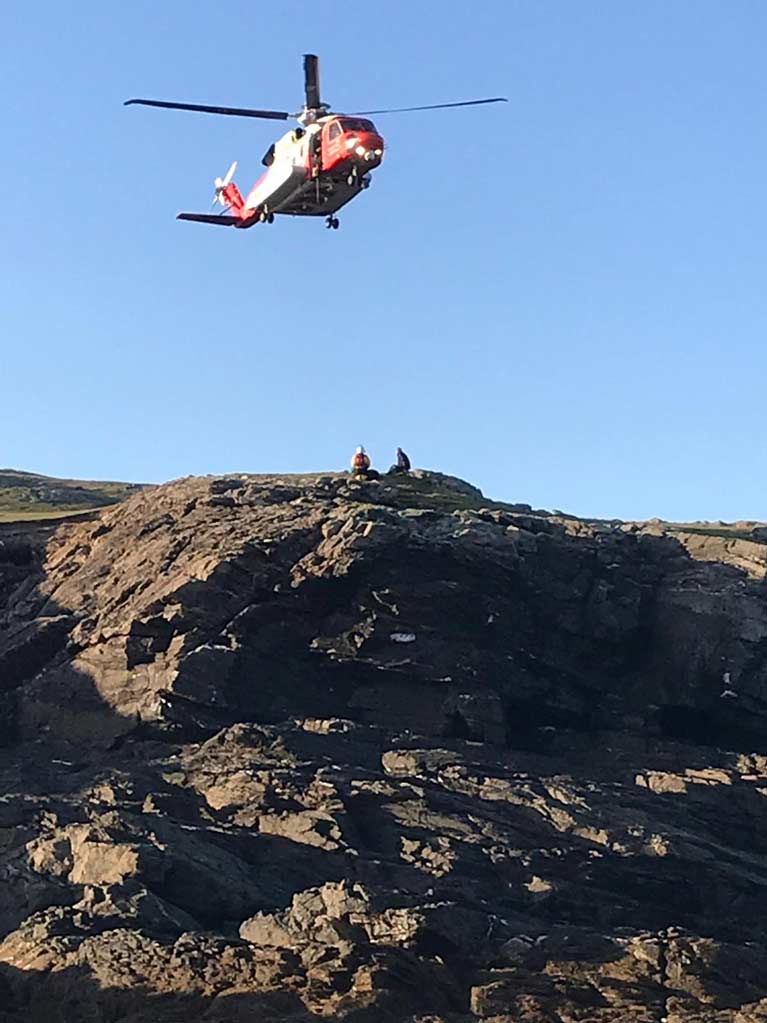 The Coastguard attend the scene
The Coastguard attend the scene
The Shannon lifeboat simultaneously provided some shelter from the southeast force 8 offshore wind and crew member Ian Shanahan was able to go ashore safely and assess the situation. The casualty appeared well but had sustained minor injuries during the ordeal so the Rescue 118 helicopter winched them both from the island and the casualty was transferred to Castlebar General Hospital. The severity of the weather meant that the yacht could not be recovered safely.
Both lifeboats returned to station at 7.20 pm and Coxswain James Mullen said “This callout was a very serious situation for a lone sailor whose equipment had failed and luckily he was able to raise the alarm by mobile phone. It really put into practice all of our combined training and seamanship skills and the rapid response times of both boats was remarkable. This was the first callout with the new Shannon Class lifeboat fully involved and it was great to be able to work together so well and effectively”.
See video of this rescue here




























